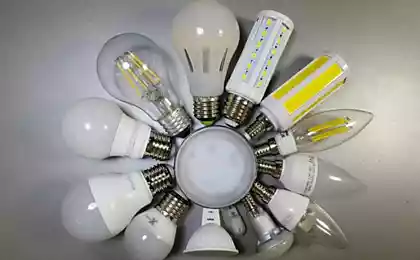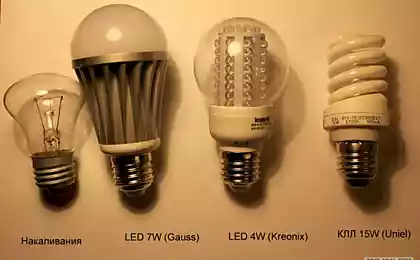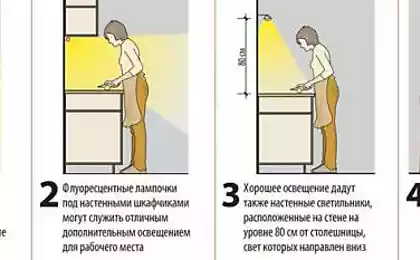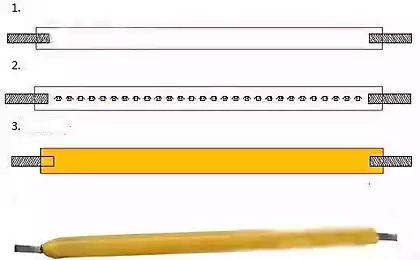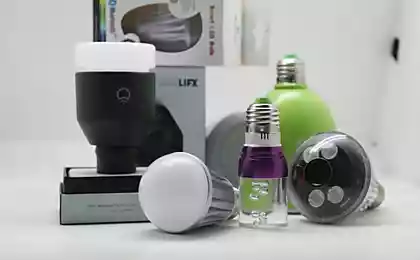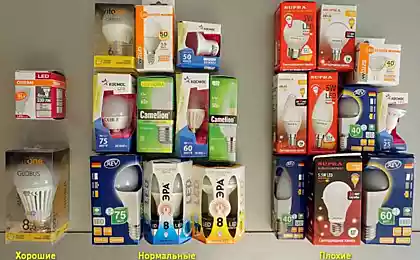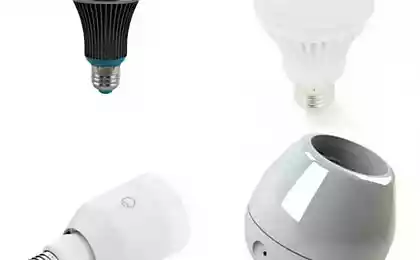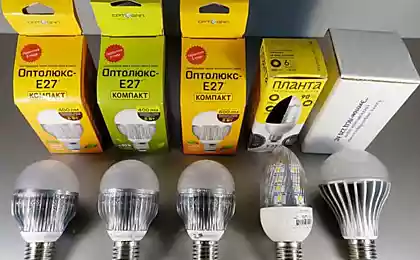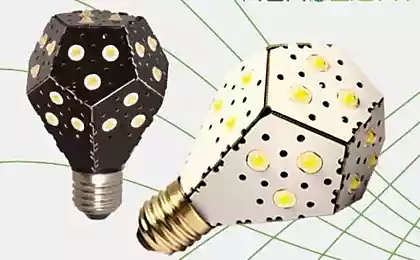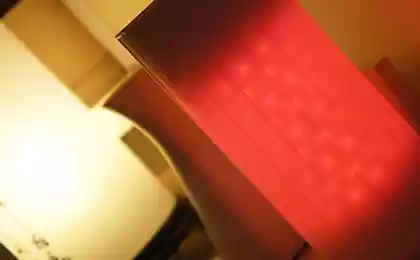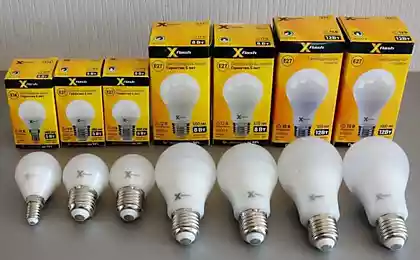561
Short life and spectacular death of the budget led bulb
Initially these lamps caught my attention because they use LEDs of the type 7020SMD (88 PCs.). The lamp has a light output of 700 lumens, which is equivalent to incandescent lamp of 60 watts. Ie I use them as a replacement of such lamps in lighting fixtures. In particular, referred to in another item of the kitchen lamp.
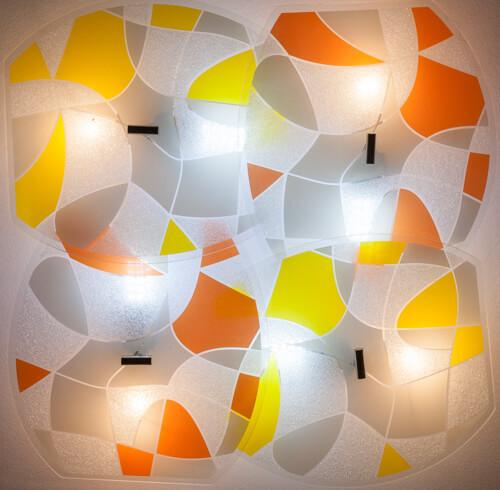
Just now contains 4 of these lamps. They still work, primarily I believe, due to the fact that the lamp in the kitchen is almost always included on a short (no more than 30 mins) period of time.
Characteristics of the source SDL Buybay Foxanon 7W 700 LM
Lamp looks like this (photo from the online store).
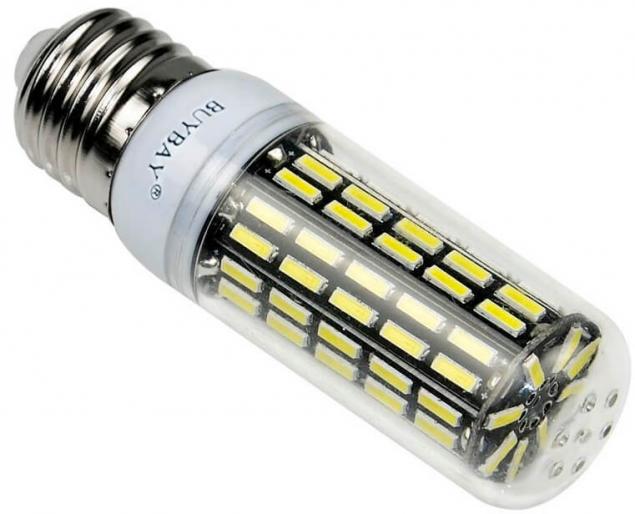
I ordered a bulb with bases E27 and E14 (warm and cold light).
Photo of burning of the LEDs:

Curious asymmetrical arrangement of the led under the phosphor film.
Let me remind you, the methods of evaluation described in the book. The table below provides information for the lamp of cold light with an E27 cap.
Transient characteristics.

Reduce electric power by 8% looks acceptable. But the fall of light (that is, in fact, luminous flux) of 21% is too much. This indirectly indicates too high a temperature of the SD, i.e. the organized poor cooling. In comparison with later developments, the lamp has holes in the upper part of the transparent cap. Newer lamps have a long slot almost the entire length of the hood.
I did two orders. The first time it was the only lamp with an E27 cap. Their characteristics (including the power meter) was virtually identical. However, when I then ordered a bulb E27 and E14 — received lamp of an entirely different quality. This was expressed:
Tellingly, when disassembling the lamp gets soldered to the power cord. Ie, the build quality of the lights is low and varies from batch to batch.
The inspection of the scene
Lamp socket E14 worked in wall sconces in a horizontal position in a cylindrical diffuser (both ends open). Used since the beginning of January of the current year to 7 March, about 5 hours a day. Ie just order 60х5=300 hours. Let me remind you, the manufacturer promised 100 000 hours, i.e. lamp worked 0.3% of the declared resource.
Consider some of the burnt SOM
Driver

The flip side
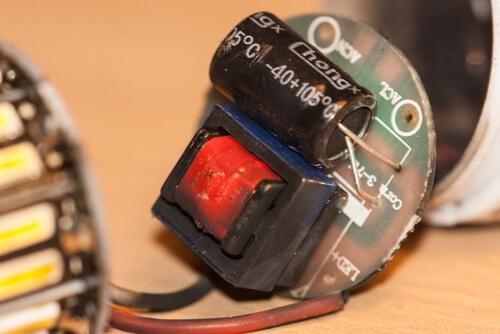
I'm not good at electrical engineering, but — it seems — a transformer was damaged and burnt out parts on the PCB. And burned things specifically, judging by the amount of soot on the plastic cap. This is one of the network cables are detached (the first picture on the left white).
An array of LEDs
First of all struck by the changed appearance of diabetes.

They were a little darker, the phosphor is transparent, and the crystals themselves SD are dark points. This indicates a high temperature.
Here is a comparison of the original and has worked 300 hours of SD.
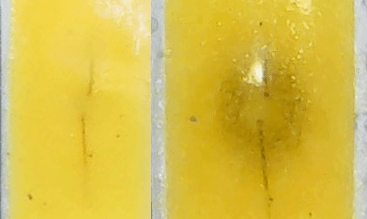
(they look lighter compared to the previous picture, as highlighted cold light LEDs USB microscope, and the white balance was not adjusted). Obviously, the SD crystal worked at a very high temperature.
Protective plastic cap
To start a new photo (right) of the cap compared to the worked.
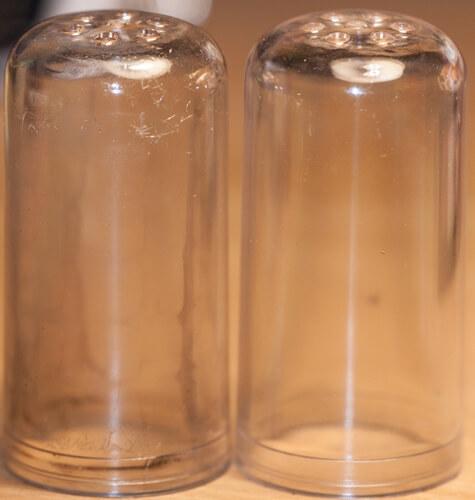
Draws attention to the abundance of soot. More interestingly, the presence of a linear (needle-like) crystals in the bottom and the top. Here the lower part is more coarsely.

The bottom cylindrical strip of dark color — this is the place where aluminum horizontal portion of the block of LEDs is closest to the adjacent plastic. Needle-like crystals are slightly higher. This is a picture of the typical chemical process of sublimation. So, for example, you can remove the mothballs — to put it in a hot bath, the molecules will vaporize and then condense in the cold part of the apparatus for sublimation (usually cooled with running water) in the form of crystals. Ie in place of maximum contiguity, hot aluminum parts, the temperature was so high that either the polymer is degraded into fragments, or (more likely) because it stood separate components. Which are then condensed in the form of needles nearby, where the temperature is already below. (Note that perhaps the release of substances from the PCB or other components of the driver.).
Unit DM comprises two such horizontal circular metal parts. Indeed, at the top of the cap there is a similar picture.
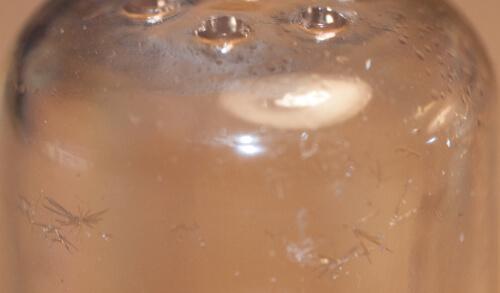
Needle-like crystals are visible at the bottom of the frame. Interestingly, in the upper right corner shows a drop of liquid. It is most likely that it's a plasticizer (quote from Wiki: "Plasticizers are substances that are injected into the polymeric materials to impart (or enhance) the elasticity and (or) plasticity in the processing and exploitation. Plasticizers facilitate the dispersion of the ingredients, lower temperature processing of the compositions, improve the frost resistance of polymers, but sometimes worsen their heat resistance. Some plasticizers can increase heat-, light - and temperature-resistant polymers."). The most widely known (but nameless to the vast majority of people) in the life of a plasticizer ester is dibutyl phthalate. Since this is a mosquito repellent. This I mean that such fluids have very high boiling point, low volatility and virtually harmless to humans (unless you take them inside).
The appearance of crystals and droplets may be due to two reasons (probably a combination): low quality plastic protective cap and too high operating tempeture SDL. Drops gathered at the top of the hood because there is the coldest region.
What can we say in conclusion? One of the advantages we can mention a fairly high efficiency of 100 LM/W and low price (140 rubles apiece).
Minuses much more.
• variation in the quality of lamps
• strong variation in the value of the luminous flux from instance to instance
• low value color rendering index for lamps cold light
• too much light fall-off when the lamp is warming up to operating temperature
• sub-optimal design protective hood, which complicates the cooling
• actual operating temperature of SDL is too high, which leads to the degradation of all its parts: the driver, the crystals of the BOD, phosphor, and even a protective cover
• bad driver, which is expressed in:
— low utilization rate of power
— in lamps without notice can be used by drivers of different types
— the failure is accompanied by the release of large amounts of soot, the driver can not be repaired.
To buy such lamps to be used without refinement makes no sense. Revision — as a minimum — should include an audit of the driver and improving the ventilation (additional holes or slots in the plastic cap and protective cap).
P. S. And remember, only by changing their consumption — together we change the world! ©
Source: geektimes.ru/post/286708/

Just now contains 4 of these lamps. They still work, primarily I believe, due to the fact that the lamp in the kitchen is almost always included on a short (no more than 30 mins) period of time.
Characteristics of the source SDL Buybay Foxanon 7W 700 LM
Lamp looks like this (photo from the online store).

I ordered a bulb with bases E27 and E14 (warm and cold light).
Photo of burning of the LEDs:

Curious asymmetrical arrangement of the led under the phosphor film.
Let me remind you, the methods of evaluation described in the book. The table below provides information for the lamp of cold light with an E27 cap.
Transient characteristics.

Reduce electric power by 8% looks acceptable. But the fall of light (that is, in fact, luminous flux) of 21% is too much. This indirectly indicates too high a temperature of the SD, i.e. the organized poor cooling. In comparison with later developments, the lamp has holes in the upper part of the transparent cap. Newer lamps have a long slot almost the entire length of the hood.
I did two orders. The first time it was the only lamp with an E27 cap. Their characteristics (including the power meter) was virtually identical. However, when I then ordered a bulb E27 and E14 — received lamp of an entirely different quality. This was expressed:
- in strong variability in the light
- in the dispersion of electric power from 5.6 to 7.3 W
- in the dispersion Km: almost all lamps have a ~0.5, but one lamp showed 0.77.
Tellingly, when disassembling the lamp gets soldered to the power cord. Ie, the build quality of the lights is low and varies from batch to batch.
The inspection of the scene
Lamp socket E14 worked in wall sconces in a horizontal position in a cylindrical diffuser (both ends open). Used since the beginning of January of the current year to 7 March, about 5 hours a day. Ie just order 60х5=300 hours. Let me remind you, the manufacturer promised 100 000 hours, i.e. lamp worked 0.3% of the declared resource.
Consider some of the burnt SOM
Driver

The flip side

I'm not good at electrical engineering, but — it seems — a transformer was damaged and burnt out parts on the PCB. And burned things specifically, judging by the amount of soot on the plastic cap. This is one of the network cables are detached (the first picture on the left white).
An array of LEDs
First of all struck by the changed appearance of diabetes.

They were a little darker, the phosphor is transparent, and the crystals themselves SD are dark points. This indicates a high temperature.
Here is a comparison of the original and has worked 300 hours of SD.

(they look lighter compared to the previous picture, as highlighted cold light LEDs USB microscope, and the white balance was not adjusted). Obviously, the SD crystal worked at a very high temperature.
Protective plastic cap
To start a new photo (right) of the cap compared to the worked.

Draws attention to the abundance of soot. More interestingly, the presence of a linear (needle-like) crystals in the bottom and the top. Here the lower part is more coarsely.

The bottom cylindrical strip of dark color — this is the place where aluminum horizontal portion of the block of LEDs is closest to the adjacent plastic. Needle-like crystals are slightly higher. This is a picture of the typical chemical process of sublimation. So, for example, you can remove the mothballs — to put it in a hot bath, the molecules will vaporize and then condense in the cold part of the apparatus for sublimation (usually cooled with running water) in the form of crystals. Ie in place of maximum contiguity, hot aluminum parts, the temperature was so high that either the polymer is degraded into fragments, or (more likely) because it stood separate components. Which are then condensed in the form of needles nearby, where the temperature is already below. (Note that perhaps the release of substances from the PCB or other components of the driver.).
Unit DM comprises two such horizontal circular metal parts. Indeed, at the top of the cap there is a similar picture.

Needle-like crystals are visible at the bottom of the frame. Interestingly, in the upper right corner shows a drop of liquid. It is most likely that it's a plasticizer (quote from Wiki: "Plasticizers are substances that are injected into the polymeric materials to impart (or enhance) the elasticity and (or) plasticity in the processing and exploitation. Plasticizers facilitate the dispersion of the ingredients, lower temperature processing of the compositions, improve the frost resistance of polymers, but sometimes worsen their heat resistance. Some plasticizers can increase heat-, light - and temperature-resistant polymers."). The most widely known (but nameless to the vast majority of people) in the life of a plasticizer ester is dibutyl phthalate. Since this is a mosquito repellent. This I mean that such fluids have very high boiling point, low volatility and virtually harmless to humans (unless you take them inside).
The appearance of crystals and droplets may be due to two reasons (probably a combination): low quality plastic protective cap and too high operating tempeture SDL. Drops gathered at the top of the hood because there is the coldest region.
What can we say in conclusion? One of the advantages we can mention a fairly high efficiency of 100 LM/W and low price (140 rubles apiece).
Minuses much more.
• variation in the quality of lamps
• strong variation in the value of the luminous flux from instance to instance
• low value color rendering index for lamps cold light
• too much light fall-off when the lamp is warming up to operating temperature
• sub-optimal design protective hood, which complicates the cooling
• actual operating temperature of SDL is too high, which leads to the degradation of all its parts: the driver, the crystals of the BOD, phosphor, and even a protective cover
• bad driver, which is expressed in:
— low utilization rate of power
— in lamps without notice can be used by drivers of different types
— the failure is accompanied by the release of large amounts of soot, the driver can not be repaired.
To buy such lamps to be used without refinement makes no sense. Revision — as a minimum — should include an audit of the driver and improving the ventilation (additional holes or slots in the plastic cap and protective cap).
P. S. And remember, only by changing their consumption — together we change the world! ©
Source: geektimes.ru/post/286708/
